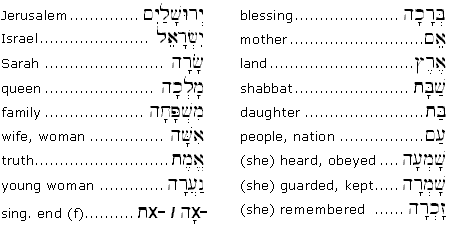|
Hebrew Feminine Singular Nouns
Every Hebrew noun is either masculine or feminine in gender and singular or plural in number. In the vocabulary list above, all the nouns are feminine singular.
Note that a noun's gender (masculine or feminine) sometimes refers to the sex of the referrent (as the word bat refers to a daughter, and ben refers to a son), but often it does not. For example, the word for land (eretz) is feminine and the word for house (bayit) is masculine. However there is nothing male or female about land or a building! You must learn the gender of a noun as part of the noun's definition.
Singular Noun Endings
Sometimes it helps to see patterns in the way words are formed. These patterns are sometimes called inflections. For Hebrew singular nouns, the pattern looks like this:

The table above shows typical endings for singular nouns. For masculine singular nouns, there is no characteristic ending added to the base stem of the word. Feminine singular nouns often end with a Hey or a Tav.
We can see how the patterns appear in the following examples:

Notice in the list above that the feminine nouns end in either Hey or Tav, but the masculine nouns show no regular pattern to their endings. Notice also that the word for truth, emet, is feminine and the word for thing, davar, is masculine (there are no masculine inflections for emet or feminine inflections for davar). Finally, be aware that most names of streets, cities and countries are feminine in Hebrew (for example, Jerusalem and Israel are both feminine nouns).
Hebrew Noun Sentences
A simple sentence in Hebrew can be constructed by simply joining two nouns together. For example,

These are complete sentences. In English, we supply the "copula" verb form ("is") to aid us in our translation, but in Hebrew, no such verb is required.
Feminine Singular Verb Forms
In Hebrew, verbs have gender and number, and every verb must agree with its subject in gender and number. Therefore, feminine singular nouns must take a feminine singular verb form. The vowel pattern for the three letter shoresh (root) of a (Qal perfect) verb in the third person feminine singular is:

Notice the vowel marks under the root letters of the verb (denoted with XXX in the pattern). This pattern is the basic vocalization for feminine singular verbs in the Qal perfect. Here are some examples:

If you can see how the three verbs in the vocabulary list all use this vowel pattern, mazel tov!, you are beginning to understand some Hebrew grammar!
Third Person Singular Verb Patterns
Sometimes it helps to see patterns in the way verbs are formed. These patterns are sometimes called conjugations. For Hebrew singular verbs in the third person ("he, she, it"), the pattern looks like this:

Here are some examples of the vowel changes:

Note again that the subject and verb must agree in gender and number:

Section Exercises
- Memorize the section vocabulary (top of the page)
- Practice writing basic sentences using these words
- Understand the difference between masculine and feminine noun forms (called inflections)
|



